The simple truth is every body responds to fasting a little differently. Genetics, health, lifestyle…all these things play a part. But for a healthy person embarking on a fasting journey, there’s a general timeline of events—a predictable set of metabolic responses as your fast stretches from hours into days. We’re breaking down that timeline here.

Between 0 and 3 hours, your body is still going through the process of ingesting and storing the last thing you ate. After your body breaks down carbs, protein, and fat into glucose, amino acids, and fatty acids, your body metabolizes them for energy or stores them for later use. Depending on the last thing you ate before starting your fast, a few different hormones could be at play in your bloodstream.
If you’ve eaten a meal heavy in carbohydrates, you’ll have a lot of glucose in your bloodstream. That means a rise in insulin. Your pancreas secretes insulin to help shuttle glucose into cells where it can immediately be used for energy production, protein synthesis in muscles, or stored for later use, either as glycogen (the short-term storage of glucose) or as adipose tissue (long-term storage). Three hours after your last meal, glucose and insulin have most likely returned to “normal” pre-meal levels.
You’ll also experience a fluctuation in ghrelin and leptin. Ghrelin, the “hunger hormone” is what turns on your appetite. Leptin does the opposite. After a meal, your ghrelin levels fall and your leptin levels rise, effectively turning your appetite off, signaling to your brain that you’re full.
The 0–3 hour time frame is what we call an anabolic, or growth period since nutrients are available and the body can burn them, build muscle with them, or store them.
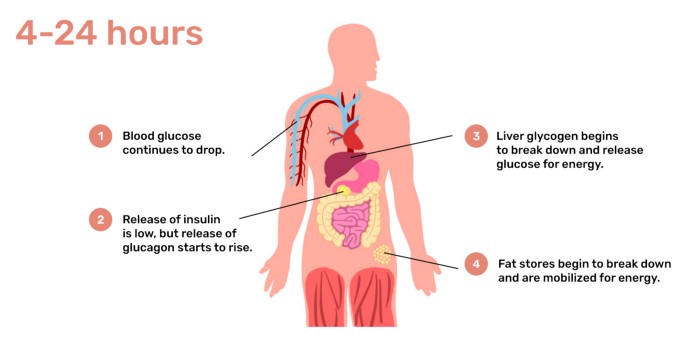
During the 4–24 hour phase, your body switches to the catabolic, or breakdown, state where stored nutrients are put to use. Once blood glucose and insulin levels drop, you’ll experience an uptick in glucagon—a catabolic hormone that stimulates the breakdown of glycogen (stored glucose) for energy. Since glucose is still your body’s main fuel source in this phase, your metabolism will attempt to break down enough glycogen to keep your blood glucose in the “normal” range (about 70–120 mg/dL).
Toward the end of this phase, you’ll likely start depleting your glycogen stores, which means you need access to another fuel source. Your body will begin the switch from glucose to ketones. Glucose is still your primary, preferred fuel source, but when your glucose reserves are nearing empty, you’ll start using fat stores and ketone bodies to make up the difference. Between 12 to 24 hours, blood glucose levels will be reduced by about 20%.
The exact time that your body starts shifting from using glucose to ketones for energy depends on how much glycogen you’ve got stored away and how much energy you’re burning throughout the day. This switch happens faster if you’re exercising since you’ll burn through your glycogen stores more quickly.
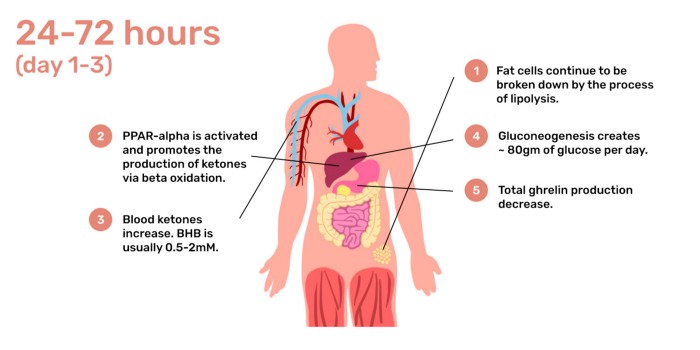
Your body is switching into fat-burning mode now—glycogen is significantly depleted, so you’ll produce and use ketone bodies for energy. Through the breakdown of fat (a process called lipolysis), fat cells in the body release free fatty acids. PPAR-alpha (a regulator of fat metabolism in the liver), which is necessary for ketogenesis, is activated and ensures those fatty acids are used.
Fatty acids travel to the liver where they are transformed into ketone bodies through the process of beta-oxidation. When we say “ketone bodies,” we’re referring to three distinct types of molecules: acetone, acetoacetate, and beta-hydroxybutyrate, or BHB for short. Your body can use both acetoacetate and BHB for energy production. Blood ketone meters, which you may have seen people use while fasting or on a ketogenic diet, measure BHB levels in the blood. BHB levels can vary based on the individual, but within 24–72 hours of fasting, you’re likely to see BHB levels rise to somewhere between 0.5–2 mM; the range for nutritional ketosis.
At this point, ketones become your primary fuel, but your brain still needs a bit of glucose to function. With none to be found in your blood, and your glycogen stores completely tapped, your body makes glucose from non-carbohydrate sources like fat, ketones, and amino acids through a process called gluconeogenesis. Yes, your body can actually make sugar out of protein and fat. During this phase of fasting, you produce about 80 grams of glucose per day using this process, most of which is used by the brain. The rest of the body can rely almost exclusively on ketone bodies.
So what’s going on with ghrelin, the hunger hormone? This deep into a fast, It actually starts to decline again. One study showed that even though ghrelin rises and falls in a cyclic pattern related to circadian rhythm, total ghrelin output decreased every 24 hours of fasting. So, by day 3, overall ghrelin output was lower than day 2 and day 1. These results may explain why overall hunger levels seem to decrease around the third day of a fast and beyond.
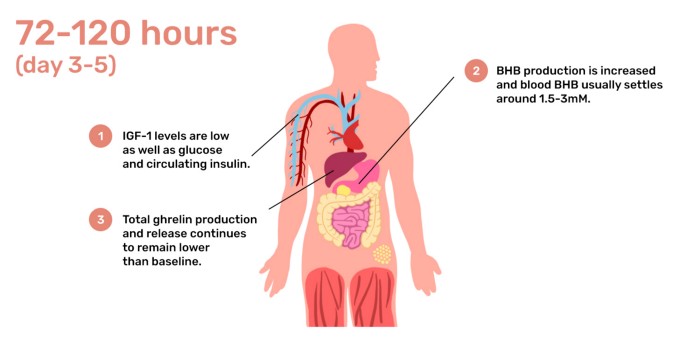
We’re now in the prolonged fasting phase. After day 3, glucose and insulin levels remain low, hunger stays suppressed, and you’re in a steady state of nutritional ketosis. You’ll also see a decrease in something called IGF-1 (insulin like growth factor). IGF-1 is a hormone involved in growth and development. When nutrients are restricted, your liver decreases its IGF-1 production, plus there’s a decrease in IGF binding proteins. Short-term decreases of IGF-1 activity in adults have been associated with less oxidative stress and may be an important part of anti-cancer and anti-aging dietary interventions.
Prolonged fasting has also been shown to activate cellular resistance to toxins and stress in both mice and human studies. A minimum of 72 hours of fasting seems to be required to experience these benefits. Fasting for 3+ days has been shown to decrease circulating insulin and glucose by 30% or more, which can contribute to decreased risk of metabolic disease. The decreased levels of growth hormone and insulin in the bloodstream also seem to have benefits for immunity, inflammation, neurogenesis, and overall metabolic health.
BHB (one of the three ketone bodies) levels continue to rise throughout your fast. At this point, they’ll likely settle out around 1.5–3 mM. BHB levels above 2.0 mM may correlate with lower hunger levels as well, since the body is now producing sufficient amount of ketones to fuel the body.
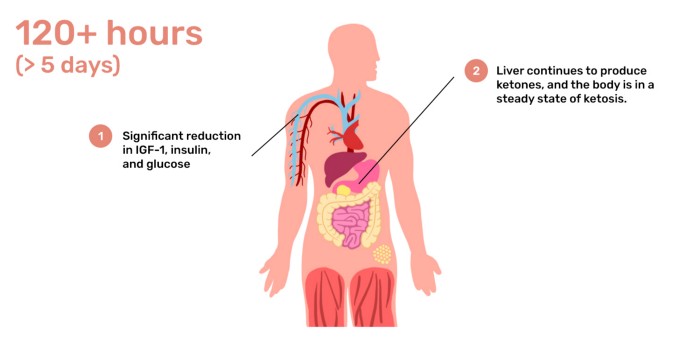
After fasting for 5 or more days, glucose, insulin, and IG-F are all significantly reduced, and you’re in a steady state of ketosis. Five days of fasting in humans has been shown to cause over a 60% decrease in IGF-1 and a significant increase in IGF-1 inhibiting proteins. After 10 days of fasting, IGF-1 levels may be as low as those seen in people with growth hormone deficiency—a population associated with reduced risk of cancer, diabetes, and overall mortality.
Conversely, BHB levels will continue to rise. It’s important to note here the difference between ketosis (burning ketones for fuel) and ketoacidosis (dangerously acidic blood from overly high ketone levels, usually only seen in alcoholics, diabetics, and cases of extreme starvation). Normally, the presence of insulin tells the body to stop increasing its production of ketones and plateau them at a safe level, but since your insulin levels remain low throughout a prolonged fast, this feedback loop doesn’t occur. One study showed that BHB levels will eventually plateau between 5–6 mM by day 20–25 of fasting. So if you’re contemplating an extremely long fast, it’s worth consulting with a medical professional to make sure you’re doing so safely.
Summary
As you can see, there is plenty of promising research on the metabolic benefits of fasting. Precisely which benefits you’ll experience depends on the duration of your fast. As always, we suggest working with a medical professional to find the plan and approach that’s best for your health and goals.
- The Complete Guide to Fat Burning - April 30, 2024
- Zero Live #4: 3 Ways to Boost Fat Burning - March 28, 2024
- Zero Live #3: Nutrition, Fast Breakers, and Fasting - March 11, 2024
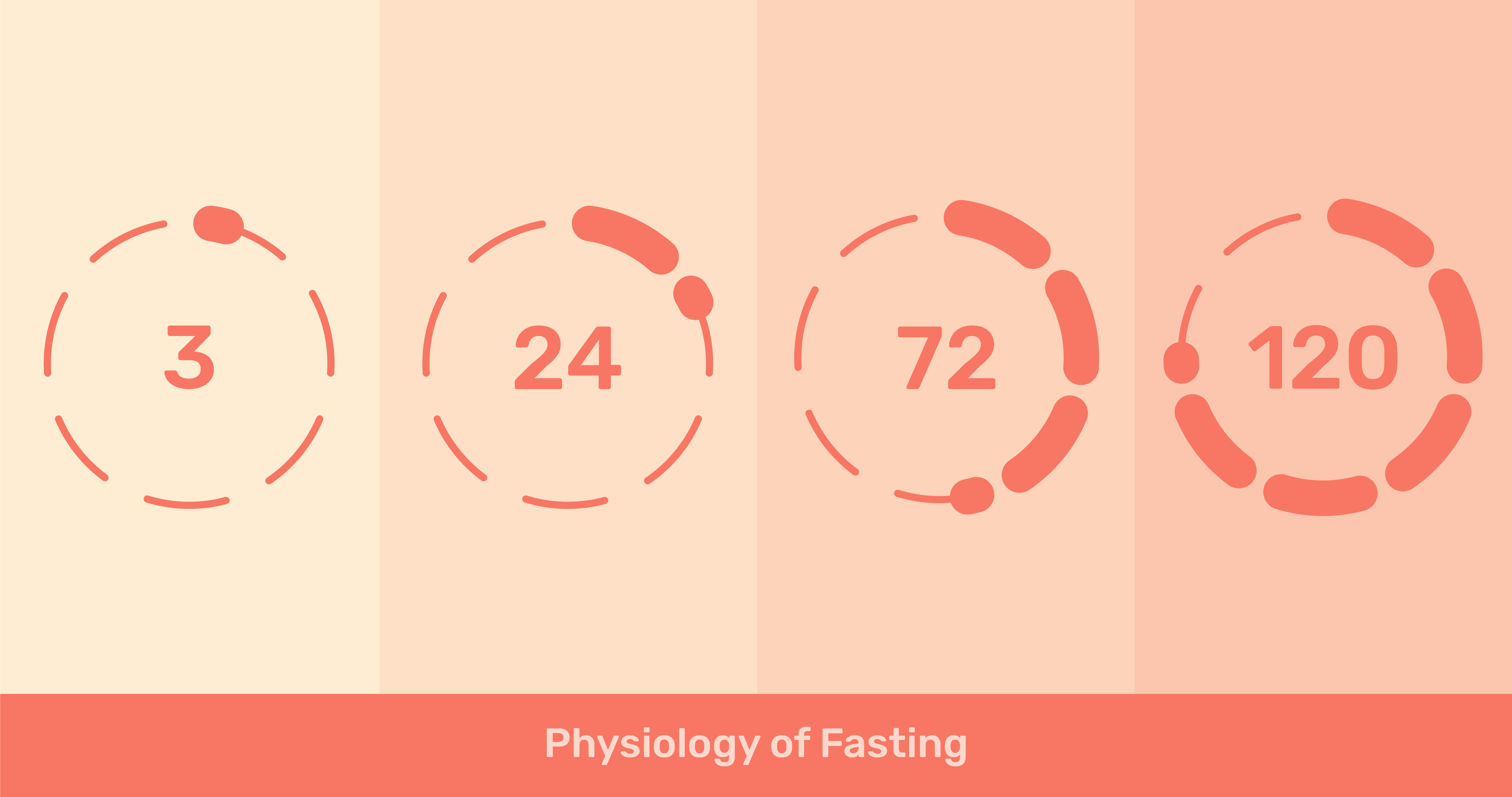
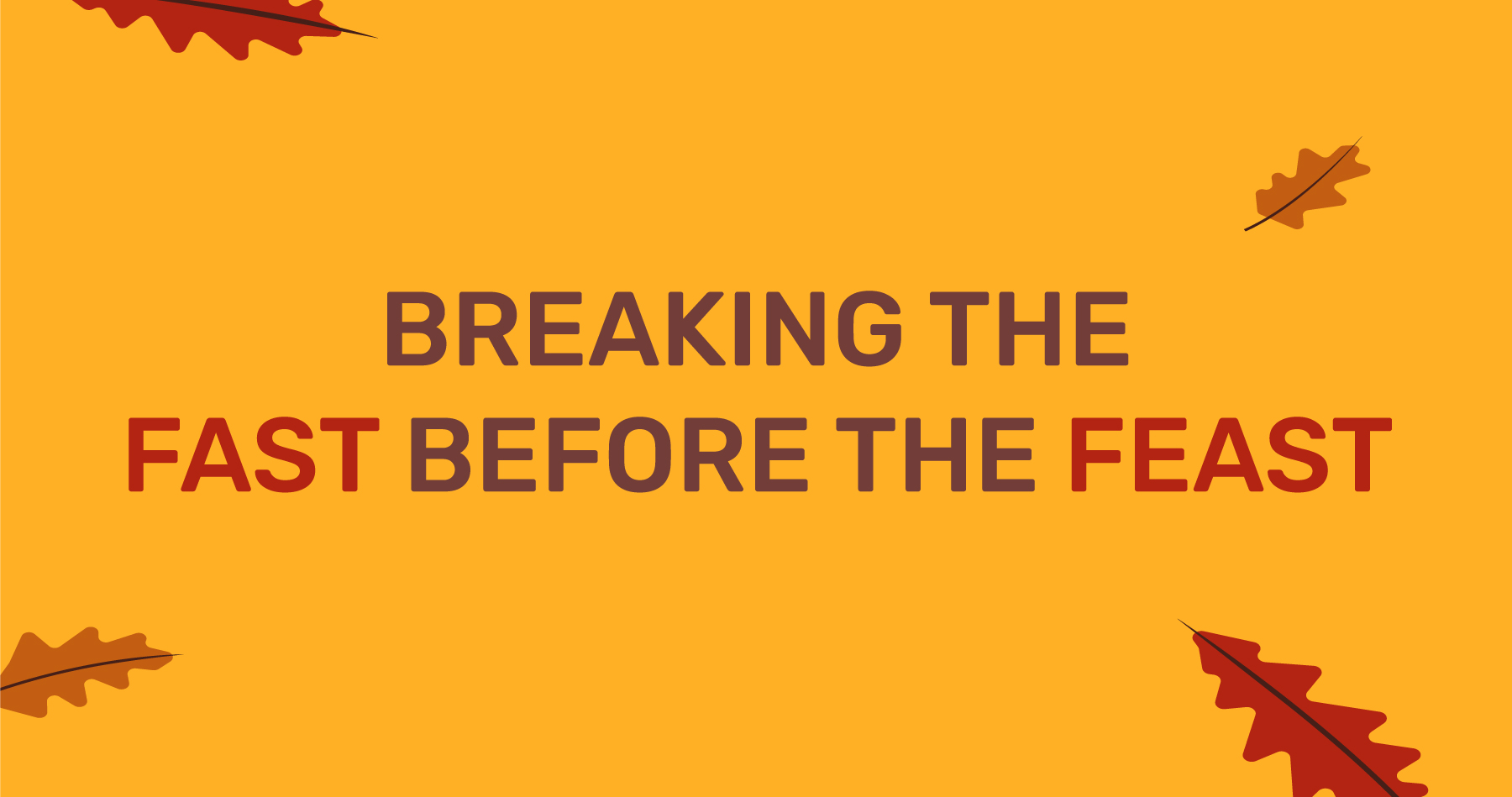


Can I make 16:8 a continuous way of life to both loose/maintain weight whilst benefiting from the positive medical outcomes as researched?
I look after an elderly parent with dementia so the stress levels can be heightened regularly for which I am prescribed Fluoxetin.
I have found first 6 days of this TRF quite easy to follow and recorded my efforts which are positive I believe I have lost at least 3-4lbs since starting, just returned from holiday where junk food and alcohol were consumed over 9 days( I do eat healthily most of the time and try to make better food choices regularly)
My goal is to stay within my prefered weight of 9-9st 7lbs as any lower makes me look too skinny and OLD!
I do look much younger than my years coming up to 65 December.
Any advice appreciated
La-Verne Lee
I am a healthy 37 yo female. I state this because I don’t know YOUR specific medical background. But I fast daily at least 16 hours. I love it. When you get your body firing at its optimal level. I feel like I think more clear, have more energy and sleep better. All this coupled together are a great combatant against stress. As a caregiver you NEED to care for yourself and a lot of people don’t understand how much their eating habits are effecting their mental state, which effects their ability to cope with stressors which effects their bodies homeostasis. It’s all one awesomely intricate and linked system. That NEEDS to be cared for and watched over.
I only eat in a 4 hour window everyday but I also follow a keto diet so I never really feel hungry. 20:4 I eat a small meal around 2pm and if I’m still hungry at 5pm that’s it.
Hi,
Do you have sources for this article?
It’s discouraged to omit the author’s name in such articles — and detracts from it’s reputation.
Kindly honor the reader, and yourself, by attributing these fine articles to the individual/s who wrote them.
Very good point, we will fix that moving forward!
Very helpful information ℹ️
I have started a Keto based diet ( less than 20g carbs/ day) with a ratio of 5%C, 70%F and 25%P on 2000 calories/day. Couple with IF of 18 hours. What if any would be the equivalent fasting duration using this regimen?
That’s a lot of calories why so much? Are you an Olympic athlete? Or 6’ 6” (203cm) tall? I do the same ratios, but consume around 1100 -1300 calories. Usually on the lower end of range. If you been doing keto for a while and you keep adapted to don’t need that many calories. Your metabolism becomes more efficient. I think for the average person 0.8 g of protein per 1kg or ideal body weight is sufficient, maybe if you train a lot you can do 1 g per kg of ideal body weight.
Beautiful article. So easy to understand. Gave me energy to my 4 days water fast.
A very wide eyed open read for the better. I’m certainally doing this. With being overweight for over 25 years I’ve tried every diet. Nothing has worked. I’m a big believer in visual learning expecially when its backed up with evidence like you have shown. Thrown in with exercise I’d like to in the future get back in touch with my results?
Why don’t drs tell you about things like this instead of saying go to slimming group?
Great article. I would like to encourage the writers to do a review of time restricted eating and it’s effect on LDL cholesterol. I’ve tried to go to the primary literature to do this myself but only have access to some full articles. Seems like the studies are all over the place in terms of results with even a few studies showing a negative effect. I’ve personally been advised to go on statins (45+ yo active, healthy male) but wanted to give time restricted eating a try before doing so. Thanks for considering.
Have you considered a whole food plant based diet? Lots of scientifically sound literature on WFPB and lowering of LDLc. Personally, my LDLc dropped in half when I changed. I think the evidence on IF and LDL is much weaker. (I still do it for weight control tho.) Check out https://www.pcrm.org/
I wish you had a “like” button for this article as it is easy to comprehend and will be referring to it on multiple occasions during my fast. Thank you!
Exactly my question!
What’s the point of doing short fasts like 16:8 besides from calorie and food reduction due to the limited window of eating?
Does this mean we don’t get the benefits listed above?
Super excited to explore this route to optimal health. I feel I’ve found a solution to burn the 5lbs of visceral fat that’s been stored on my gut for over 20 years. After two days of fasting 16hrs- I can already feel/see the difference.
I’m pretty sure I broke my fast I had some shrimp for New Years Eve but hey it’s New Years Eve.
Happy New Years Every one
I’m sorry. I guess I missed something important. If ketosis doesnt start until 16+ hours, is the 16:8 plan not going to work?
Not if you continue to eat a regular diet with lots of carbs and sugar. The 16/8 plan works great with the keto diet because you are taking in very few carbs and no sugar which keeps the glucose stores in your body at a minimum which allows the 16/8 plan to quickly burn off the glucose/carbs and get back into burning fat, even if it’s only for 2-4 hours each day. That 2-4 hours per day adds up quickly as you continue the keto/16/8 over the coming months. I’ve been watching Dr Ken Berry and Thomas DeLaurer on youtube and they are both very knowledgeable, and they have explained that after doing keto and 16/8 fasting you can get back into ketosis at approximately 12-14 hours, but you can speed up that time table quite a bit with exercise.
Awesome, thank you for the reply. 🙂
You can hit Ketosis with 12-16 hours of fasting so the 16:8 will work well. It’s actually what I do daily and I love it. How quickly your body can start hitting Ketosis will also depend up to this point what your diet has been like. You can also help achieve it more effectively in your fast if you are adding exercise to your plan.
What does 16/8 mean?
I’m not an expert by any means, but if ketosis is what your looking for fasting can help you get there much quicker. But if you want to maintain ketosis you’ll have to eat low carb or continue fasting longer. Ketosis isn’t a magic bullet, but a state of being. Even accessing ketosis for a few hours per fast should help your metabolism.
I am doing a 3 day fast and i am only half way threw. I seem to be really struggling to get to sleep at nights.. all I can think about is Blumin food and I’m wide awake till about 1am 😐
I really appreciate this article since most illnesses are from over nourishment and a sedentary lifestyle..this gradual calorie reduction overtime is the solution for the vast majority of people to gain benefits. Provided the ravages of the disease hasn’t already done excessive harm. Thanks for the articles, the inspiration, and the app— life-changing.
Thanks for finally writing about Loved it!| а
I would love to see an article for fasting for those with type 1 diabetes. I have issues where my blood sugar drops significantly in the early morning.
Hi
I started doing 16:8 now i am on 20:4. I am calorie counting every day and stay between 1000 and 1500 calories per day. I have been steadily losing weight every week since i started 7 weeks ago. All up i have lost 11kgs in 7 weeks. My question is will 20:4 be good for me to continue to lose weight or should i try a longer fast every now and then?
I just started my 7 days fast. 🙂